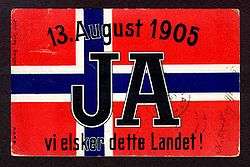Ja, vi elsker dette landet
| English: Yes, we love | |
|---|---|
 | |
|
National anthem of | |
| Lyrics | Bjørnstjerne Bjørnson, 1859-1868 |
| Music | Rikard Nordraak, 1864 |
| Adopted | 1864 |
|
| |
| Music sample | |
| Ja, vi elsker (Instrumental) | |
![]() "Ja, vi elsker dette landet" (In English: "Yes, we love this country"), also known by the title "Song For Norway", is a patriotic anthem, which has been commonly regarded as the de facto national anthem of Norway since early 20th century, after being used alongside Sønner av Norge since the 1860s. The lyrics were written by Bjørnstjerne Bjørnson between 1859 and 1868, and the melody was written by his cousin Rikard Nordraak sometime during the winter of 1863-1864. It was first performed publicly on 17 May 1864 in connection with the 50th anniversary of the constitution. Usually only the first and the last two verses are sung.
"Ja, vi elsker dette landet" (In English: "Yes, we love this country"), also known by the title "Song For Norway", is a patriotic anthem, which has been commonly regarded as the de facto national anthem of Norway since early 20th century, after being used alongside Sønner av Norge since the 1860s. The lyrics were written by Bjørnstjerne Bjørnson between 1859 and 1868, and the melody was written by his cousin Rikard Nordraak sometime during the winter of 1863-1864. It was first performed publicly on 17 May 1864 in connection with the 50th anniversary of the constitution. Usually only the first and the last two verses are sung.
As a national anthem
Until the mid-1860s, the older anthems Sønner av Norge and Norges Skaal were commonly regarded as the Norwegian national anthems, with Sønner av Norge being most recognised. Ja, vi elsker dette landet gradually came to be recognised as a national anthem from the mid-1860s. Until the early 20th century, however, both Sønner av Norge and Ja, vi elsker were used alongside, with Sønner av Norge being preferred in official situations. In 2011, the song Mitt lille land featured prominently in all the memorial ceremonies following the 2011 Norway attacks and was described by the media as "a new national anthem."[1] On the Norwegian Constitution Day in 2012, the NRK broadcast was opened with "Mitt lille land."[2]
Lyrics and literal translation
Bjørnson wrote in a modified version of the Danish language current in Norway at the time. Written Bokmål has since then been altered in a series of orthographic reforms intended to distinguish it from Danish and bring it closer to spoken Norwegian. The text below, and commonly in use today, is identical to Bjørnson's original in using the same words, but with modernised spelling and punctuation. The most sung verses, 1, 7 and 8, have been modernised most and have several variations in existence. For example, Bjørnson originally wrote «drømme på vor jord», which some sources today write as «drømme på vår jord», while others write «drømmer på vår jord».
| Norwegian Wikisource has original text related to this article: |
In each verse the last two lines are sung twice, and one or two words are repeated an extra time when the lines are sung the second time (for example "senker" in the first verse). These words are written in italics in the Norwegian lyrics below. The first verse is written down in full as an example.
|
Ja, vi elsker dette landet 1 |
Yes, we love this country 1 |
2 |
|
3 |
3 |
4 |
4 |
5 |
|
6 |
6 |
7 |
7 |
8 |
8 |
Poetic translation and metric version
The three commonly used stanzas of Ja, vi elsker were translated into English long ago. The name of the translator is seldom mentioned in printed versions of the English text. It has so far not been possible to identify the person responsible or to ascertain when it was translated. But the following versions of stanzas 1, 7, and 8 are well known and often sung by descendants of Norwegian immigrants to the United States. Its popularity and familiarity among Norwegian-Americans seems to indicate that it has been around for a long time, certainly since before the middle of the 20th century, and possibly much earlier. This translation may be regarded as the "official" version in English.
|
1 |
Yes, we love with fond devotion |
Metrical versions
Two alternative metrical version are also in existence. The second version follows the original closely, and was learnt by heart by a Norwegian[3] who did not know the name of the translator. It has been published (without the name of the translator) in a collection of Sange og digte paa dansk og engelsk[4] [Songs and Poems in Danish and English]. Two small changes in this text has been done in the version, which is presented here. Verse 2, which is seldom sung, has been omitted, and the last two lines in each verse are repeated, in the same way as we sing it in Norwegian.
|
1 |
Norway, thine is our devotion, |
Yes, we love this land arising
Stormbeat o'er the sea With its thousand homes, enticing, Rugged though it be. Love it, love it, not forgetting Those we owe our birth, Nor that night of saga letting Down its dreams to earth, Nor that night of saga letting Down its dreams, its dreams, to earth. Norseman, where thou dwellest, render Praise and thanks to Him, Who has been this land's defender, When its hopes looked dim. Wars our fathers' aims unfolded, Tears our mothers shed, Roads of them for us He molded, To our rights they led. Roads of them for us He molded, To our rights, our rights, they led. Yes, we love this land arising Stormbeat o'er the sea With its thousand homes, enticing, Rugged though it be. Like our fathers who succeeded, Warring for release, So will we, whenever needed, Rally for its peace. So will we, whenever needed, Rally for its peace, its peace. |
Deleted verse a tribute to King Charles IV
A verse hailing Charles IV who had succeeded his father as king of Norway in July 1859 was included in the original version of "Ja, vi elsker". However, following the divisive international events of the spring of 1864 where the ideal of a unified Scandinavia was coldly shattered, Bjørnson went from being a monarchist to republicanism, and the tribute to the reigning sovereign was stricken from the song.
The lyrics that were taken out were:
- Kongen selv staar stærk og aapen
- som vaar Grænsevagt
- og hans allerbedste Vaapen
- er vor Broderpagt.
In English this reads:
- The King himself stands strong and open
- As our border guard
- and his most powerful weapon
- is our brethren pact.
The "brethren pact" which the text is referring to was a military treaty between Norway, Sweden and Denmark to come to the assistance should one of the nations come under military assault. This happened when German troops invaded South Jutland in February 1864. None of the alliance partners came to the rescue of Denmark. This perceived treason of the "brethren pact" once and for all shattered many people's dreams of unification of the three countries.[5]
Controversies

In 1905 the Union between Sweden and Norway was dissolved after many years of Norwegian struggle for equality between the two states, as stipulated in the 1815 Act of Union. The unilateral declaration by the Norwegian Storting of the union's dissolution 7 June provoked strong Swedish reactions, bringing the two nations to the brink of war in the autumn. In Sweden, pro-war conservatives were opposed by the Social Democrats, whose leaders Hjalmar Branting and Zeth Höglund spoke out for reconciliation and a peaceful settlement with Norway. Swedish socialists sang Ja, vi elsker dette landet to demonstrate their support for the Norwegian people’s right to secede from the union.
During World War II, the anthem was used both by the Norwegian resistance and the Nazi collaborators, the latter group mainly for propaganda reasons. Eventually, the German occupiers officially forbade any use of the anthem.
In May 2006, the multicultural newspaper Utrop proposed that the national anthem be translated into Urdu, the native language of the most numerous group of recent immigrants to Norway.[6] The editor's idea was that people from other ethnic groups should be able to honour their adopted country with devotion, even if they were not fluent in Norwegian. This proposal was referred to by other more widely read papers, and a member of the Storting called the proposal "integration in reverse".[7] One proponent of translating the anthem received batches of hate-mail calling her a traitor and threatening her with decapitation.[8]
See also
References
- ↑ Verdig tilstandsrapport fra nasjonalartistene Archived December 29, 2013, at the Wayback Machine., BT.no
- ↑ Lindahl, Björn (2001-09-11). "Norsk festyra fick ny dimension" (in Swedish). Svenska Dagbladet. Retrieved 2012-05-26.
- ↑ Torolv Hustad, born around 1930.
- ↑ Volk, John, ed. (1903). Sange og digte paa dansk og engelsk. New York Public Library, digitized by Google: "Nordlysets" forlag. pp. 30–31.
- ↑ Bomann-Larsen, Tor (2002). "Alt for Norge". Kongstanken. Haakon & Maud (in Norwegian). 1. Oslo, Norway: J.W. Cappelen. pp. 23–24. ISBN 82-02-19092-4.
- ↑ Vil ha «Ja vi elsker» på urdu Archived May 11, 2008, at the Wayback Machine.
- ↑ Fr.p. sier nei til "Ja vi elsker" på urdu Archived May 21, 2006, at the Wayback Machine.
- ↑ "Archived copy". Archived from the original on 2013-09-27. Retrieved 2006-12-30.
JA VI ELSKER DETTE LANDET / Orkesterplass versjon (copyright © 2015) Hans Jørgen Langeland / Opprinnelig ideen og piano Elisabeth Karsten / Vokal Andreu Jacob / Musikalsk arrangement go orchestration
External links
- National Anthem of Norway sung a cappella and with Norwegian subtitles. Hosted by YouTube
- Sung May 1, 2005 in Salt Lake City Utah with Mormon Tabernacle Choir and Norwegian soprano Sissel Kyrkjebø; first stanza only and then in English
